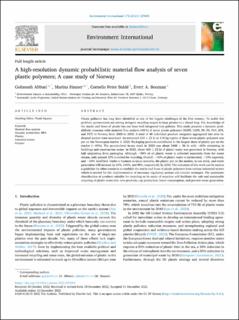| dc.description.abstract | Plastic pollution has long been identified as one of the biggest challenges of the 21st century. To tackle this problem, governments are setting stringent recycling targets to keep plastics in a closed loop. Yet, knowledge of the stocks and flows of plastic has not been well integrated into policies. This study presents a dynamic probabilistic economy-wide material flow analysis (MFA) of seven plastic polymers (HDPE, LDPE, PP, PS, PVC, EPS, and PET) in Norway from 2000 to 2050. A total of 40 individual product categories aggregated into nine industrial sectors were examined. An estimated 620 ± 23 kt or 114 kg/capita of these seven plastic polymers was put on the Norwegian market in 2020. Packaging products contributed to the largest share of plastic put on the market (∼40%). The accumulated in-use stock in 2020 was about 3400 ± 56 kt with ∼60% remaining in buildings and construction sector. In 2020, about 460 ± 22 kt of plastic waste was generated in Norway, with half originating from packaging. Although ∼50% of all plastic waste is collected separately from the waste stream, only around 25% is sorted for recycling. Overall, ∼50% of plastic waste is incinerated, ∼15% exported, and ∼10% landfilled. Under a business-as-usual scenario, the plastic put on the market, in-use stock, and waste generation will increase by 65%, 140%, and 90%, respectively by 2050. The outcomes of this work can be used as a guideline for other countries to establish the stocks and flows of plastic polymers from various industrial sectors which is needed for the implementation of necessary regulatory actions and circular strategies. The systematic classification of products suitable for recycling or be made of recyclate will facilitate the safe and sustainable recycling of plastic waste into new products, cap production, lower consumption, and prevent waste generation. | en_US |

